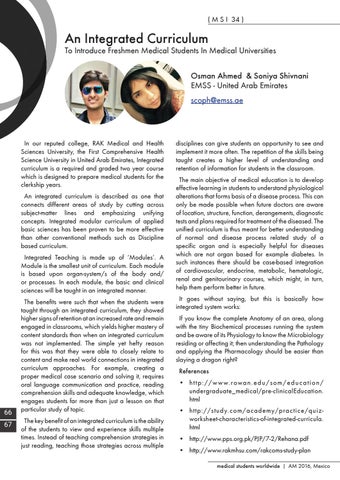( M S I 34 )
An Integrated Curriculum
To Introduce Freshmen Medical Students In Medical Universities Osman Ahmed & Soniya Shivnani EMSS - United Arab Emirates scoph@emss.ae
In our reputed college, RAK Medical and Health Sciences University, the First Comprehensive Health Science University in United Arab Emirates, Integrated curriculum is a required and graded two year course which is designed to prepare medical students for the clerkship years. An integrated curriculum is described as one that connects different areas of study by cutting across subject-matter lines and emphasizing unifying concepts. Integrated modular curriculum of applied basic sciences has been proven to be more effective than other conventional methods such as Discipline based curriculum. Integrated Teaching is made up of ‘Modules’. A Module is the smallest unit of curriculum. Each module is based upon organ-system/s of the body and/ or processes. In each module, the basic and clinical sciences will be taught in an integrated manner.
66 67
The benefits were such that when the students were taught through an integrated curriculum, they showed higher signs of retention at an increased rate and remain engaged in classrooms, which yields higher mastery of content standards than when an integrated curriculum was not implemented. The simple yet hefty reason for this was that they were able to closely relate to content and make real world connections in integrated curriculum approaches. For example, creating a proper medical case scenario and solving it, requires oral language communication and practice, reading comprehension skills and adequate knowledge, which engages students far more than just a lesson on that particular study of topic. The key benefit of an integrated curriculum is the ability of the students to view and experience skills multiple times. Instead of teaching comprehension strategies in just reading, teaching those strategies across multiple
disciplines can give students an opportunity to see and implement it more often. The repetition of the skills being taught creates a higher level of understanding and retention of information for students in the classroom. The main objective of medical education is to develop effective learning in students to understand physiological alterations that forms basis of a disease process. This can only be made possible when future doctors are aware of location, structure, function, derangements, diagnostic tests and plans required for treatment of the diseased. The unified curriculum is thus meant for better understanding of normal and disease process related study of a specific organ and is especially helpful for diseases which are not organ based for example diabetes. In such instances there should be case-based integration of cardiovascular, endocrine, metabolic, hematologic, renal and genitourinary courses, which might, in turn, help them perform better in future. It goes without saying, but this is basically how integrated system works: If you know the complete Anatomy of an area, along with the tiny Biochemical processes running the system and be aware of its Physiology to know the Microbiology residing or affecting it; then understanding the Pathology and applying the Pharmacology should be easier than slaying a dragon right? References • h t t p : / / w w w. rowa n . e d u / s o m / e d u c a t i o n / undergraduate_medical/pre-clinicalEducation. html • http://study.com/academy/practice/quizworksheet-characteristics-of-integrated-curricula. html • http://www.pps.org.pk/PJP/7-2/Rehana.pdf • http://www.rakmhsu.com/rakcoms-study-plan medical students worldwide | AM 2016, Mexico
